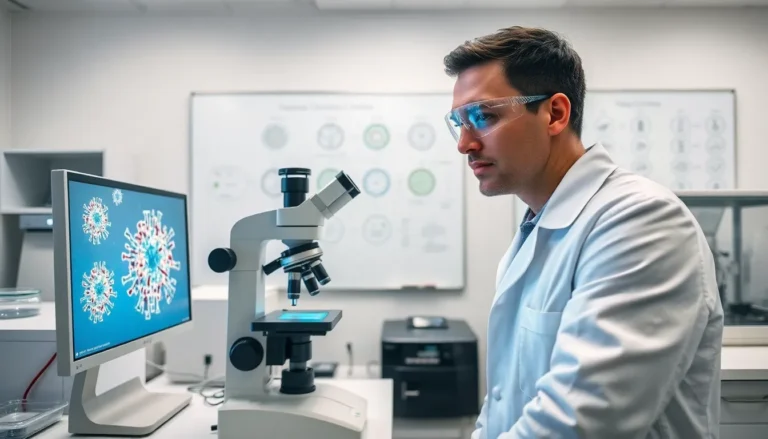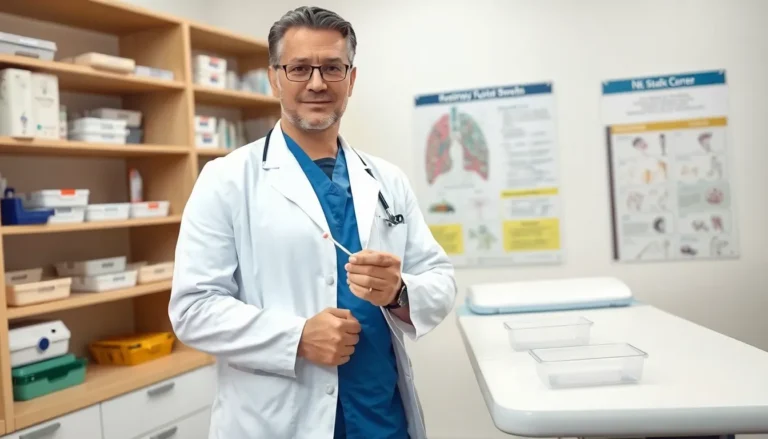Table of Contents
ToggleUnderstanding genetic relationships can be fascinating, especially when it comes to family ties. First cousins often share a unique bond, but how much DNA do they actually share? This question not only intrigues those curious about their ancestry but also plays a crucial role in genetic research and health assessments.
First cousins typically share about 12.5% of their DNA. This percentage reflects the genetic connection that arises from having a common set of grandparents. As families grow and branches expand, knowing this shared DNA can help individuals navigate their family history and understand hereditary traits. Exploring these connections sheds light on the intricate web of genetics that shapes who we are.
Understanding DNA and Genetics
DNA, or deoxyribonucleic acid, serves as the hereditary material in humans and most organisms. It carries genetic instructions vital for growth, development, functioning, and reproduction.
What is DNA?
DNA consists of two long strands forming a double helix, made up of nucleotides. Each nucleotide contains a phosphate group, a sugar molecule, and one of four nitrogenous bases: adenine (A), thymine (T), cytosine (C), or guanine (G). The sequence of these bases encodes genetic information, determining an individual’s unique traits.
How is DNA Inherited?
DNA is inherited through a process involving meiosis and fertilization. Each parent contributes half of their DNA to their child, with 23 chromosomes coming from the mother and 23 from the father. This combination results in genetic variations among siblings and cousins. First cousins share about 12.5% of their DNA because they have a common set of grandparents, which contributes to their genetic similarities.
The Concept of Genetic Relatedness

Genetic relatedness defines the shared DNA between individuals and helps illustrate familial connections. First cousins, for instance, share about 12.5% of their DNA due to their common grandparents, a significant amount that influences hereditary traits.
Measuring Genetic Similarity
Measuring genetic similarity involves analyzing the percentage of shared DNA. Geneticists often utilize DNA tests, which examine specific genetic markers, to determine relatedness. First cousins share approximately 12.5% of their DNA, which corresponds to 1,562.5 megabases (Mb) on average. This measurement demonstrates a closer genetic relationship compared to more distant relatives like second cousins, who share about 3.125% of their DNA. Tools such as autosomal DNA testing provide insight into these relationships, allowing individuals to trace their ancestry and uncover family connections.
The Role of Shared DNA in Family Relationships
Shared DNA plays a crucial role in establishing family relationships. The 12.5% of DNA shared by first cousins reflects their familial ties and can influence inherited traits, health conditions, and genetic predispositions. This genetic connection helps family members understand their ancestry while informing them about potential health risks that may run in the family. Understanding the implications of shared DNA strengthens the bond between relatives and aids in the exploration of family history.
How Much DNA Do First Cousins Share?
First cousins typically share about 12.5% of their DNA, amounting to roughly 1,562.5 megabases (Mb) on average. This genetic connection stems from their shared grandparents, influencing various family traits and health conditions.
Average DNA Shared Between First Cousins
First cousins inherit DNA in a unique manner. Each parent contributes half of their genetic material, leading to the 12.5% shared DNA statistic. This percentage signifies a more substantial genetic link than that found between second cousins, who share about 3.125%. Geneticists utilize DNA testing to identify these shared segments, providing insights into familial connections and ancestry.
Factors Affecting DNA Sharing
Several factors can affect the percentage of shared DNA among first cousins.
- Generational Distance: The deeper the common ancestry, the less shared DNA. For example, half-cousins share about 6.25%, while first cousins once removed share around 6.25% as well.
- Genetic Variation: Each individual carries unique genetic variations, influenced by biological parents. As a result, this variation can lead to differences in the exact percentage of DNA shared among first cousins.
- Population Genetics: Certain populations may exhibit higher levels of relatedness due to historical intermarriage, impacting DNA similarities among cousins.
Understanding these factors aids in comprehending the complexity of genetic relationships within families.
Implications of Shared DNA
The shared DNA between first cousins has important implications for understanding family dynamics and genetic health. This connection offers insights into hereditary traits and potential health risks.
Understanding Family Trees
Family trees visually represent genetic relationships, illustrating how individuals connect through shared ancestors. In a typical family tree, first cousins emerge from siblings, demonstrating the direct line of descent from common grandparents. These diagrams aid in comprehending complex familial ties, with each branch indicating different branches of ancestry. Recognizing these connections helps individuals navigate their genealogy, understand inherited traits, and explore family histories. Accurate family trees can uncover relationships that impact genetic traits, leading to a richer understanding of one’s identity.
Impacts on Genetic Testing
Shared DNA among first cousins significantly influences genetic testing outcomes. Genetic tests, often used for ancestry tracking or health assessments, reveal similarities in specific DNA segments, confirming the degree of relatedness. When analyzing test results, first cousins expect to see about 12.5% shared genetic markers, equating to 1,562.5 megabases on average. This percentage aids individuals in identifying inherited health conditions prevalent within families. Furthermore, understanding the shared genetic information enhances awareness of potential genetic predispositions to diseases, guiding healthcare decisions and preventive measures. With DNA testing, individuals can interpret the implications of their genetic heritage, highlighting its value in both personal and medical contexts.
First cousins share a unique genetic bond that plays a crucial role in understanding family dynamics and health. This 12.5% DNA overlap not only sheds light on ancestry but also impacts genetic testing and health assessments. By recognizing these connections, individuals can better navigate their family histories and uncover potential hereditary traits.
As the complexity of genetics unfolds, the insights gained from shared DNA can guide healthcare decisions and enhance awareness of inherited conditions. Exploring these relationships fosters a deeper appreciation for one’s genetic heritage, ultimately enriching personal identities and familial ties.







